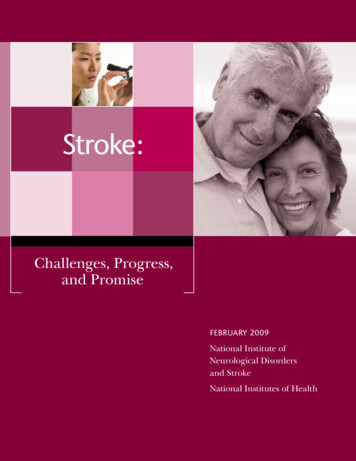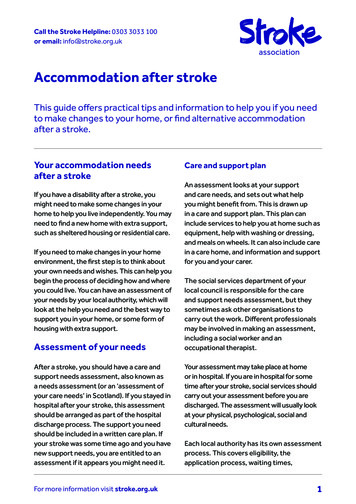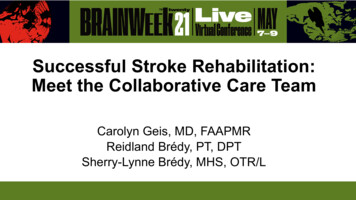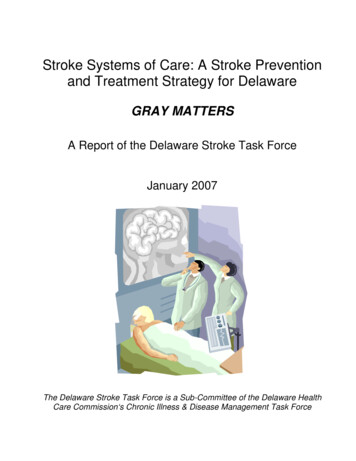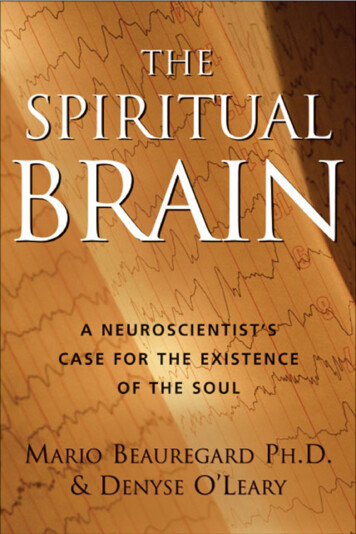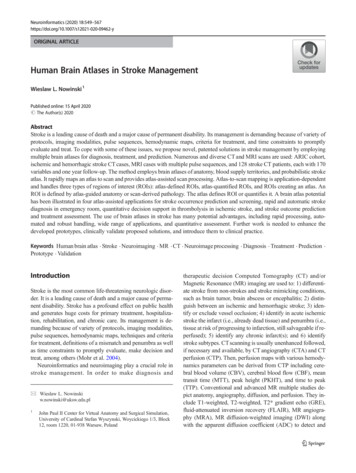
Transcription
Neuroinformatics (2020) 62-yORIGINAL ARTICLEHuman Brain Atlases in Stroke ManagementWieslaw L. Nowinski 1Published online: 15 April 2020# The Author(s) 2020AbstractStroke is a leading cause of death and a major cause of permanent disability. Its management is demanding because of variety ofprotocols, imaging modalities, pulse sequences, hemodynamic maps, criteria for treatment, and time constraints to promptlyevaluate and treat. To cope with some of these issues, we propose novel, patented solutions in stroke management by employingmultiple brain atlases for diagnosis, treatment, and prediction. Numerous and diverse CT and MRI scans are used: ARIC cohort,ischemic and hemorrhagic stroke CT cases, MRI cases with multiple pulse sequences, and 128 stroke CT patients, each with 170variables and one year follow-up. The method employs brain atlases of anatomy, blood supply territories, and probabilistic strokeatlas. It rapidly maps an atlas to scan and provides atlas-assisted scan processing. Atlas-to-scan mapping is application-dependentand handles three types of regions of interest (ROIs): atlas-defined ROIs, atlas-quantified ROIs, and ROIs creating an atlas. AnROI is defined by atlas-guided anatomy or scan-derived pathology. The atlas defines ROI or quantifies it. A brain atlas potentialhas been illustrated in four atlas-assisted applications for stroke occurrence prediction and screening, rapid and automatic strokediagnosis in emergency room, quantitative decision support in thrombolysis in ischemic stroke, and stroke outcome predictionand treatment assessment. The use of brain atlases in stroke has many potential advantages, including rapid processing, automated and robust handling, wide range of applications, and quantitative assessment. Further work is needed to enhance thedeveloped prototypes, clinically validate proposed solutions, and introduce them to clinical practice.Keywords Human brain atlas . Stroke . Neuroimaging . MR . CT . Neuroimage processing . Diagnosis . Treatment . Prediction .Prototype . ValidationIntroductionStroke is the most common life-threatening neurologic disorder. It is a leading cause of death and a major cause of permanent disability. Stroke has a profound effect on public healthand generates huge costs for primary treatment, hospitalization, rehabilitation, and chronic care. Its management is demanding because of variety of protocols, imaging modalities,pulse sequences, hemodynamic maps, techniques and criteriafor treatment, definitions of a mismatch and penumbra as wellas time constraints to promptly evaluate, make decision andtreat, among others (Mohr et al. 2004).Neuroinformatics and neuroimaging play a crucial role instroke management. In order to make diagnosis and* Wieslaw L. Nowinskiw.nowinski@uksw.edu.pl1John Paul II Center for Virtual Anatomy and Surgical Simulation,University of Cardinal Stefan Wyszynski, Woycickiego 1/3, Block12, room 1220, 01-938 Warsaw, Polandtherapeutic decision Computed Tomography (CT) and/orMagnetic Resonance (MR) imaging are used to: 1) differentiate stroke from non-strokes and stroke mimicking conditions,such as brain tumor, brain abscess or encephalitis; 2) distinguish between an ischemic and hemorrhagic stroke; 3) identify or exclude vessel occlusion; 4) identify in acute ischemicstroke the infarct (i.e., already dead tissue) and penumbra (i.e.,tissue at risk of progressing to infarction, still salvageable if reperfused); 5) identify any chronic infarct(s); and 6) identifystroke subtypes. CT scanning is usually unenhanced followed,if necessary and available, by CT angiography (CTA) and CTperfusion (CTP). Then, perfusion maps with various hemodynamics parameters can be derived from CTP including cerebral blood volume (CBV), cerebral blood flow (CBF), meantransit time (MTT), peak height (PKHT), and time to peak(TTP). Conventional and advanced MR multiple studies depict anatomy, angiography, diffusion, and perfusion. They include T1-weighted, T2-weighted, T2* gradient echo (GRE),fluid-attenuated inversion recovery (FLAIR), MR angiography (MRA), MR diffusion-weighted imaging (DWI) alongwith the apparent diffusion coefficient (ADC) to detect and
550assess the infarct, and/or MR perfusion-weighted imaging(PWI) to calculate the perfusion maps in order to delineatethe penumbra.A typical clinical practice is to process all these multiplestudies individually by visual inspection. This causes the process to be time consuming in the situation when “time isbrain” and not quantitative, while certain conditions have tobe calculated accurately to make the therapeutic decision. Inorder to cope with some of these problems we have proposed aparadigm shift in stroke image processing by employing human brain atlases. This shift is from a 2D visual inspection ofindividual scans to atlas-assisted quantification and simultaneous visualization of multiple 2D and 3D images (Nowinskiet al. 2008).Human brain atlases are central to this approach. Over thelast century brain atlases and maps have progressed tremendously from a few print cortical maps to a plethora of electronic, deformable, probabilistic, multi-modal, and multi-scalebrain atlases in health and disease (Toga et al. 2006; Evanset al. 2012; Amunts et al. 2014; Nowinski 2017a). The brainatlases have been employed in a wide scope of applicationsranging from medical education to research to clinics asreviewed in (Nowinski 2017a). One of clinical applicationsof brain atlases is neuroradiology (Nowinski 2016) and, consequently, stroke image handling. The use of human brainatlases in stroke management opens new application avenueswhich subject is addressed below.I propose here some novel concepts and methods in strokemanagement by employing multiple human brain atlases. Thisnovelty is confirmed by our numerous patents granted (and 17US stroke-related patents are listed in Appendix). The way ofusing brain atlases in handing stroke images is also new and ithas several advantages. I address a potential usefulness of andsummarize our preliminary experience in the development ofprototypes equipped with various brain atlases for stroke occurrence prediction and screening, rapid and automatic strokediagnosis in emergency room (ER), quantitative decision support in thrombolysis in ischemic stroke, and stroke outcomeprediction and treatment assessment.Methods, Materials and ApplicationsMethodsThe stroke applications employ three various brain atlases.These are the atlas of anatomy (Nowinski 2005), atlas of bloodsupply territories (Nowinski et al. 2006a), and ProbabilisticStroke Atlas (PSA) (Nowinski et al. 2014a).The atlas of anatomy was derived from the Talairach andTournoux (1988) brain atlas by its postprocessing, extensions,and color coding (Nowinski et al. 1997) followed by its continuous enhancements (Nowinski 2005). The atlas of bloodNeuroinform (2020) 18:549–567supply territories was created to spatially correspond to theatlas of anatomy. Both atlases have the same shape of thecortex and ventricular system, share outlines of the cerebellumand brainstem, and have the same image size, number of thecorresponding images, and image resolution. Consequently,these two atlases are in natural spatial registration.The PSA combines neurological parameters with pathology localized on neuroimages for a population of stroke patients. This atlas aggregates a multiplicity of diverse parameters and presents the distribution of each parameter as a 3Dimage. The PSA is a special case of the probabilistic braindamage atlas for stroke lesions discussed below.The overall method has, generally, two major steps: 1)mapping of the atlas(es) to a patient’s scan (or vice versa),and 2) atlas-assisted scan (or perfusion map) processing.Atlas-to-scan mapping (or spatial registration) methods,producing an individualized atlas, have been reviewed in(Nowinski 2017b), and any known methods can be employedin the stroke applications discussed below. In our stroke prototypes developed we used our own atlas-to-scan mappingmethods because they are very fast (of a few seconds), automatic with no parameter setting, conceptually simple (also forthe clinicians to understand the underlying processing), andeasier to us to modify, extend and integrate them into strokeapplications. Moreover their validation, although tedious andtime consuming, is conceptually straightforward. Two mainmethods used for atlas-to-scan mapping are the Fast TalairachTransformation (FTT) (Nowinski et al. 2006b) and an ellipsebased fitting method (Volkau et al. 2012).The FTT is a rapid version of the Talairach transformation(Talairach and Tournoux 1988) with the modified Talairachlandmarks introduced by Nowinski (2001). The originalTalairach transformation subdivides the brain into 12 cuboidalregions and scales it piece-wise linearly. The FTT was implemented and its performance evaluated for MR neuroimages.The identification of the point and distributed landmarks in thescan by the FTT is fully automatic and performed in threesteps: calculation of the midsagittal plane (MSP), computingof the anterior (AC) and posterior commissure (PC) pointlandmarks, and calculation of the six external cortical landmarks. Having the MSP and the landmarks calculated, theprocessed scan is reformatted in the AC-PC plane, and theatlas is scaled piecewise linearly and superimposed on thescan.The algorithm for the MSP extraction localizes the interhemispheric fissure line segments by sampling the vicinity ofthis fissure with five pairs of sampling parallel line segments(that cover the white and gray matters and cerebrospinal fluidregions around the interhemispheric fissure) in a coarse andfine steps, selects fissure line segment inliers by applying ahistogram-based angular and distance outlier removal, andcalculates the equation of the MSP from the selected inliersby means of the least square error fit (Hu and Nowinski 2003).
Neuroinform (2020) 18:549–567The algorithm for a rapid and automatic localization of theAC and PC point landmarks combines anatomic and radiologic properties of the AC and PC and their surrounding structures (Bhanu Prakash et al. 2006). These landmarks are localized in two stages, coarse and fine. In the coarse stage thelandmarks are identified on the given MSP by analyzing theirrelationships with the corpus callosum, fornix, and brainstem.Subsequently, in the fine stage their positions are refined in awell-defined volume of interest by analyzing locations of thelateral and third ventricles, interhemispheric fissure, and massa intermedia. The algorithm exploits simple operations including histogramming, thresholding, region growing, and1D projections.The modified Talairach cortical landmarks are calculatedon three 2D planes, the AC-PC axial plane and two perpendicular coronal planes passing through the AC and PC landmarks, in contrast to the need of processing the entire brain in3D as in the original Talairach transformation (Nowinski2001). Then, for each modified cortical landmark a singlecoordinate is calculated, as opposed to three coordinates required for the corresponding original cortical landmark. Forthe calculated MSP, AC and PC, these three planes are determined, and the brain images on them are segmented based onrange-constrained thresholding and morphological operationsfollowed by local refinement to determine their extents inorder to locate the cortical landmarks (Hu et al. 2005). Thisalgorithm also exploits anatomic knowledge and employs only simple operations, like thresholding, basic morphologicaloperations, and distance transform.In order to increase the accuracy of the FTT withoutcompromising its performance, we introduced two additionallandmarks calculated automatically: the top of the corpuscallosum and the most ventral point of the orbito-frontal cortex (Nowinski and Bhanuprakash 2005), doubling in this waythe subdivision of the cerebrum from 12 to 24 cuboidal regions and increasing the number of degrees of freedom of theFTT from 13 to 15. Another extension of the FTT aimed tocompensate against a variable size of the ventricular system.The standard FTT was followed by the complete and automatic extraction of the ventricular system (Xia et al. 2004) alongwith the determination of some point landmarks on its surfaceand, subsequently, by nonlinear warping based on radial functions (Nowinski et al. 2006b).In general, the use of anatomic and radiologic domainknowledge makes the FTT component algorithms more rapid,accurate, and robust. On the other hand, these algorithms become acquisition-dependent and may require additional development. For instance, to calculate the MSP for the diffusion images and perfusion maps, we developed a dedicatedalgorithm based on the Kullback-Leibler’s (KL) measurequantifying the difference between two intensity distributions(Nowinski et al. 2006c). Then, the MSP is a sagittal plane withthe highest KL measure.551Besides being acquisition-dependent, another limitation ofthe FTT (similarly to the original Talairach transformation) isthat it requires the landmarks to be present in the scan. Thismay not be the case in the ER where typically high slicethickness CT scans are acquired. In order to overcome theselimitations, while keeping the conceptual simplicity and speedof the atlas-to-scan mapping, an ellipse-based fitting methodwas devised (Volkau et al. 2012). The method is based on anobservation that the shape of the cortex on the MSP can bewell approximated by an ellipse, so practically this approachapplies to any image modality as long as the cortex is visible.In addition, anatomic positions of some cortical and subcortical landmarks are related to the parameters of this ellipticalapproximation. The ellipse-based method applies an atlastransformation similar to that of the FTT, but the landmarksare determined differently. The method enables a statisticallocalization of landmarks in any, including sparse, scans,where the landmark points are hardly discernible or even absent. The method performs the following steps: calculation ofthe MSP by means of the KL-measure (Volkau et al. 2006a),setting a sagittal slab around the MSP and computing themaximum intensity projection (MIP) slice with the outline ofthe cortex (to compensate for a variable width of the interhemispheric fissure), identification of the fiducial points onthe outline of the cortex on the MIP slice, fitting an ellipseto the cortex, calculation of the ellipse parameters, computation of the point landmarks, and atlas-to-scan mapping(Volkau et al. 2012). The algorithm for the calculation of theMSP based on the KL-measure works in two stages, coarseand fine (Volkau et al. 2006a). In the coarse stage the centralslice in the volume along the sagittal direction is identified, avolume of interest (VOI) around this central slice in the sagittal direction is determined, the first slice of the VOI is takenas the reference slice, the KL-measure for all the slices in theVOI with respect to the reference slice is computed, and theslice with the maximum KL-measure is selected as the coarseMSP. In the fine stage, three corner points selected on thecoarse MSP are perturbed and the KL-measure is iterativelycalculated for a decreasing VOI. The set of the corner pointsgiving the maximum value of the KL-measure defines the fineMSP. The outline of the cortex on the MIP slice may be setquickly interactively or any automatic skull-stripping algorithm can be used, such as (Hu et al. 2005; Sadananthanet al. 2010) for MR scans and skull-based thresholding(Puspitasari et al. 2009) for CT scans. The later approachmay take longer time, be acquisition-dependent (in contrastto the whole mapping method) and create some artifacts, especially in the skull base region, whereas the fiducial pointsshould preferably cover the entire region between theorbitofrontal and occipital cortex. The statistically determinedpoint landmarks are ellipse-dependent; for instance, the locations of the AC and PC are simply calculated in terms of themajor and minor axes of the fitted ellipse.
552CT scans are infrequently acquired in the ER with a considerable head tilt, large slice thickness and high partial volume effect. In order to cope with these acquisitions, the algorithm for calculation of the MSP was extended by estimatingpatient’s head orientation by means of a model fitting (a skullbased fitting on the axial plane), image processing and atlasbased techniques, followed by volume reorientation for a better initialization and a subsequent MSP calculation based onthe KL-measure (Puspitasari et al. 2009).Processing of the scan with the individualized(superimposed) atlas is application-dependent. In order to process a stroke scan (or generally scans and/or maps), a combination of methods is applied including image processing, statistical modeling, atlas-assisted analysis, and populationbased atlases. What is common in these applications is thatthe processing handles certain regions of interest (ROIs) in thescan or map. These ROIs can be two-dimensional (2D, planar)or three-dimensional (3D, volumetric). The ROIs can be determined by some characteristics of a healthy brain like anatomy or by pathology. Three situations of an ROI employmentare considered here and, consequently, three types of ROIs aredistinguished: atlas-defined ROIs (type I), atlas-quantifiedROIs (type II), and ROIs creating an atlas (type III).The atlas-defined ROI is a region in the scan determined bythe superimposed atlas on it, such as the hippocampus, centralsulcus, or Brodmann’s area 17. Then, certain operations performed over the scan can be limited only to this ROI.Subsequently, the results of operations over the atlas-definedROIs can be further processed including their comparison oraggregation.The atlas-quantified ROI is a particular region (typically alesion) or regions delineated in the scan that is/are subsequently quantified by the individualized atlas or atlases. This quantification is in terms of a list of all atlas structures overlappingwith this ROI, and for each structure its quantitative contribution to this ROI in terms of a volume and percentage ofoccupancy.In type III ROIs (i.e., ROIs creating an atlas) the content ofall the ROIs is aggregated across a patient population to forman atlas. For this purpose I introduce here a concept of aprobabilistic brain damage atlas (PBDA). The PBDA is ameans of aggregating data and knowledge from the previouslytreated patients with local brain damage. A brain damaged canresult from disease or injury, such as brain tumor, stroke, trauma or infection. For each patient, the damaged (single ormulti-focal) region is segmented (delineated) in the scan andsome measure or parameter quantifying the brain damage orits state related to this specific region is assigned to it. Thesimplest way of aggregation of patient population data is byaveraging, although more sophisticated aggregations takinginto account the size, shape, location, and mutual overlappingof the contributing ROIs can be employed as analyzed in(Nowinski et al. 2014a). The PBDA forms a set of 3DNeuroinform (2020) 18:549–567volumes and each volume corresponding to the examined parameter is calculated as follows:For each parameterFor each case/scanDelineate ROI and create its contour fileNormalize spatially the contour fileFor each voxel within the normalized contour fileAggregate the parameter valueDivide the aggregated values by the number of casesThe PBDA volumes can be processed, analyzed, and visualized as well as trends and knowledge extracted from them.MaterialsNumerous and diverse cases have been used in the implemented stroke systems (prototypes) for validation. They can bearranged in four groups: 1) the ARIC (Atherosclerosis Riskin Communities) large longitudinal epidemiologic cohortstudy [URL, ARIC, 2020] with T1-, T2- and PD-weighted,spatially corresponding scans employed for the stroke occurrence prediction; 2) ischemic stroke and hemorrhagic strokeCT cases used for the ischemic stroke CT system and thestroke system in the ER; 3) MRI cases with multiple pulsesequences including T1-weighted, T2-weighted, FLAIR,MRA, DWI, and PWI maps (including CBV, CBF, MTT,PKHT and TTP) employed for the ischemic stroke MR system; and 4) 128 stroke cases used for the creation and validation of the PSA (selected from the cohort of 458 clinicallyconfirmed ischemic stroke patients, chosen from a largergroup of more than 700 patients), each case with CT scans(at admission and follow-up), contoured infarct(s), 170 variables (demographic, laboratory (including biochemical), andclinical measures and outcomes (including stroke scales))gathered within one year follow-up.Atlas-Assisted Stroke ApplicationsFour stroke preliminary applications are developed and described below, where the brain atlases are critical core components, aiming to support stroke occurrence prediction, strokedetection in the ER, making treatment decision in ischemicstroke, and stroke treatment assessment and outcomeprediction.Atlas-Assisted Stroke Occurrence PredictionWhite matter hyperintensities (WMHs) or leukoaraiosis isconsidered the main imaging sign of cerebral small vesseldiseases. WMHs are hyperintense on FLAIR and T2weighted sequences, and isointense or hypointense on T1weighted sequences with respect to normal brain (Pantoni
Neuroinform (2020) 18:549–5672010). A number of studies have demonstrated that WMHsare associated with an increased stroke risk (Moran et al.2012) and its recurrence (Kim et al. 2014). WMHs are quantified typically by the Fazekas scale (Fazekas et al. 1987)which divides the white matter in the periventricular and deepwhite matter, and each region is given a grade between 0 and 3depending on the size and confluence of lesions. This gradingis performed visually. Our goal was to attempt to automate thisassessment and make it more quantitative and objective.The processing for atlas-assisted stroke occurrence prediction contains the following steps:1. Segmentation of WMHs, generally, by any method. Here,because of the nature of the available data, we employed amulti-modal segmentation of T1-, T2- and PD-weightedimages with a simple, user-controlled thresholding basedon the known intensity ranges (i.e., bright, iso and dark) ofWMHs for these three pulse sequences.2. Creating contours around the segmented (binary) regionswith the control points for potential editing to enhance thesegmented WMHs by employing the contour editor described in (Nowinski et al. 2012a).3. Extraction of the ventricular system in 3D by an automatic, domain knowledge-driven algorithm (Xia et al. 2004).Then, the ventricular system is subdivided into multipleROIs, and in each of them local statistics is calculated, aseed point is determined and directional region growingapplied while checking anti-leakage conditions. All theunconnected regions grown are subsequently connectedby relaxing the original growing conditions.4. Quantification of the extracted binarized WMHs in termsof the number of loci, their volume, and spatial relationships with respect to the ventricular system.5. Mapping of the anatomic atlas on the images by means ofthe FTT (Nowinski et al. 2006b).6. Atlas-assisted analysis based on type II ROIs.Atlas-Assisted Stroke Diagnosis in the Emergency RoomThe first-line diagnosis for emergency evaluation of acutestroke is unenhanced (non-contrast) CT (Lövblad and Baird2010). However, its sensitivity is only 25% versus 86% inMR; moreover, within the first 3 h, it is lowered to 7% forCT and 46% for MR (Chalela et al. 2007). In addition, thescans are frequently viewed initially by non-stroke clinicians(including emergency physicians, non-neuroradiologists, oreven neurology or radiology residents, or junior staff onduty) before being interpreted by stroke neuroradiologists(Brown et al. 2004). Therefore, an automatic and fast detection and localization of ischemic infarcts in non-contrast CTcould assist in enhancing and expediting diagnosis. Our goal553is to address these issues by providing a relevant enhancingtool.Any pathology in a brain scan typically results in asymmetry between the left and right hemispheres, so by identifyingthis asymmetry, a pathology in the scan can be detected(Volkau et al. 2006b). This global comparison of the hemispheres can be followed by a more specific local comparisonfor a set of numerous pairs of ROIs placed on both hemispheres, and those ROIs can be generated by a brain atlas.The developed atlas-assisted stroke system in the ER exploitstwo atlases to define such pairs of ROIs: atlases of anatomyand atlas of blood supply territories. The system supports rapid and automatic stroke detection, distinguishes between anischemic and hemorrhagic stroke, and localizes an infarct orhemorrhage. It analyzes statistically the differences betweenthe left and right hemispheres in multiple ROIs delineated bythe brain atlases of anatomy and blood supply territories. Thecomparison between the left and right hemispheres is performed in 3D within the corresponding atlas ROIs rather thanin acquired images, avoiding image asymmetry resulting froma potential head tilt.The processing steps for atlas-assisted stroke diagnosis inthe ER exploit fast and dedicated algorithms and are asfollows:1. Calculation of the midsagittal plane (Volkau et al. 2006a;Puspitasari et al. 2009).2. Extraction of the ventricular system to determine cerebrospinal fluid regions. Three algorithms have been developed for this purpose, 1) the abovementioned algorithmfor extraction of the ventricular system from MR scans(Xia et al. 2004), 2) an algorithm for extraction of theventricular system from CT scans (Liu et al. 2010), and3) a dedicated algorithm for ventricular system extractionfrom ischemic stroke CT scans (Poh et al. 2012). Thealgorithm by Liu et al. (2010) is model-guided and employs domain knowledge about the anatomy, shape variation and intensity distribution of the normal ventricularsystem in CT neuroimages. A 3D model of the ventriclesderived from the anatomy atlas is first registered to thescan linearly against the brain’s bounding box. The registered model defines multiple regions in the ventricularsystem. Then, in each region thresholds are calculatedand the cerebrospinal fluid segmented. The automatedalgorithm by Poh et al. (2012) is template-based and employs two ventricular templates: one is for the normalbrain and the other is pathologic built from several brainswith substantially enlarged ventricles. The templates areregistered piece-wise linearly to the scan by employingthe ellipse-fitting method (Volkau et al. 2012) with theMSP calculation algorithm by Puspitasari et al. (2009)to accommodate for large head tilts. An ROI is determinedby means of the pathologic template, which limits
5543.4.5.6.7.Neuroinform (2020) 18:549–567potential “leakage” of the cerebrospinal fluid region intothe ischemic region, as their densities overlap. A suitablethreshold is computed taking into account the distributions of cerebrospinal fluid, white matter and gray mattercalculated by means of the algorithm by Gupta et al.(2010), and a thresholding is performed in the ROI,followed by artifact removal.Skull removal and brain extraction by performing skullbased thresholding (Puspitasari et al. 2009).Removal of the cerebrospinal fluid regions from the extracted brain because the cerebrospinal fluid density rangeoverlaps with that of infarcts.Rapid atlas to CT scan mapping using the ellipse-fittingmethod (Volkau et al. 2012).Atlas-assisted analysis based on type I ROIs by comparison of all the corresponding left and right ROIs for bothatlases, and a diagnosis is made based on testing of multiple statistical conditions (like a mismatch between theROIs density distribution curves).Producing a report with the diagnosis (infarct, hemorrhage, infarct with hemorrhagic transformation, or notdetected) and lesion location details (CT slices, anatomicstructures and blood supply territories).it on some (usually one or two) selected slice(s). An atlasassisted analysis provides the complete list of anatomic structures and blood supply territories, along with their volume andpercentage of contributions to the infarct and penumbraregions.The processing for atlas-assisted treatment decision making in ischemic stroke is the following:1. Calculation of the midsagittal plane by means of variousalgorithms depending on the pulse sequence (Hu andNowinski 2003; Nowinski et al. 2006c; Volkau et al.2006a).2. Rapid atlas to scan mapping by means of the FTT for MRscans (Nowinski et al. 2006b) or by the ellipse-basedmethod for CT scans (Volkau et al. 2012).3. Infarct and penumbra (ROIs) segmentation. The infarct issegmented automatically by means of a divergence measure taken here as a ratio of the intensity probability density functions for the left and right hemispheres (BhanuPrakash et al. 2008). The penumbra is delineated interactively by employing a dedicated contour editor (Nowinskiet al. 2012a). These operations are followed by the calculation of the infarct and penumbra volumes and their ratio.4. Atlas-assisted analysis based on type II ROIs and decisionmaking support (Nowinski et al. 2006a).Atlas-Assisted Treatment Decision Making in Ischemic StrokeThrombolysis is the main treatment for acute ischemic strokedelivered by administering tissue plasminogen activator (tPA) intravenously and/or intra-arterially through amicrocatheter (Mohr et al. 2004). Intravenous (IV) thrombolysis is the most direct treatment of most ischemic strokes.Uncontrolled thrombolysis may result in hemorrhagic transformation, so the procedure is applied provided that certainthrombolysis conditions are met. Depending on a protocolemployed, three conditions are checked: 1) the size of theinfarct to that of the middle cerebral artery (MCA) territory,2) the presence of a diffusion-perfusion mismatch measured asthe perfus
Stroke Atlas (PSA) (Nowinski et al. 2014a). The atlas of anatomy was derived from the Talairach and Tournoux (1988)brainatlasbyitspostprocessing,extensions, and color coding (Nowinski et al. 1997) followed by its con-tinuous enhancements (Nowinski 2005). The atlas of blood supply territories was created to spatially correspond to the atlas of .

